// Copyright 2015 The Chromium Authors. All rights reserved.
// Use of this source code is governed by a BSD-style license that can be
// found in the LICENSE file.
import 'dart:collection';
import 'dart:math' as math;
import 'dart:typed_data';
import 'dart:ui' as ui show Gradient, lerpDouble;
import 'package:flutter/foundation.dart';
import 'package:vector_math/vector_math_64.dart';
import 'alignment.dart';
import 'basic_types.dart';
class _ColorsAndStops {
_ColorsAndStops(this.colors, this.stops);
final List<Color> colors;
final List<double> stops;
}
/// Calculate the color at position [t] of the gradient defined by [colors] and [stops].
Color _sample(List<Color> colors, List<double> stops, double t) {
assert(colors != null);
assert(colors.isNotEmpty);
assert(stops != null);
assert(stops.isNotEmpty);
assert(t != null);
if (t <= stops.first)
return colors.first;
if (t >= stops.last)
return colors.last;
final int index = stops.lastIndexWhere((double s) => s <= t);
assert(index != -1);
return Color.lerp(
colors[index], colors[index + 1],
(t - stops[index]) / (stops[index + 1] - stops[index]),
);
}
_ColorsAndStops _interpolateColorsAndStops(
List<Color> aColors,
List<double> aStops,
List<Color> bColors,
List<double> bStops,
double t,
) {
assert(aColors.length >= 2);
assert(bColors.length >= 2);
assert(aStops.length == aColors.length);
assert(bStops.length == bColors.length);
final SplayTreeSet<double> stops = SplayTreeSet<double>()
..addAll(aStops)
..addAll(bStops);
final List<double> interpolatedStops = stops.toList(growable: false);
final List<Color> interpolatedColors = interpolatedStops.map<Color>(
(double stop) => Color.lerp(_sample(aColors, aStops, stop), _sample(bColors, bStops, stop), t)
).toList(growable: false);
return _ColorsAndStops(interpolatedColors, interpolatedStops);
}
/// Base class for transforming gradient shaders without applying the same
/// transform to the entire canvas.
///
/// For example, a [SweepGradient] normally starts its gradation at 3 o'clock
/// and draws clockwise. To have the sweep appear to start at 6 o'clock, supply
/// a [GradientRotation] of `pi/4` radians (i.e. 45 degrees).
@immutable
abstract class GradientTransform {
/// A const constructor so that subclasses may be const.
const GradientTransform();
/// When a [Gradient] creates its [Shader], it will call this method to
/// determine what transform to apply to the shader for the given [Rect] and
/// [TextDirection].
///
/// Implementers may return null from this method, which achieves the same
/// final effect as returning [Matrix4.identity].
Matrix4 transform(Rect bounds, {TextDirection textDirection});
}
/// A [GradientTransform] that rotates the gradient around the center-point of
/// its bounding box.
///
/// {@tool sample}
///
/// This sample would rotate a sweep gradient by a quarter turn clockwise:
///
/// ```dart
/// const SweepGradient gradient = SweepGradient(
/// colors: <Color>[Color(0xFFFFFFFF), Color(0xFF009900)],
/// transform: GradientRotation(math.pi/4),
/// );
/// ```
@immutable
class GradientRotation extends GradientTransform {
/// Constructs a [GradientRotation] for the specified angle.
///
/// The angle is in radians in the clockwise direction.
const GradientRotation(this.radians);
/// The angle of rotation in radians in the clockwise direction.
final double radians;
@override
Matrix4 transform(Rect bounds, {TextDirection textDirection}) {
assert(bounds != null);
final double sinRadians = math.sin(radians);
final double oneMinusCosRadians = 1 - math.cos(radians);
final Offset center = bounds.center;
final double originX = sinRadians * center.dy + oneMinusCosRadians * center.dx;
final double originY = -sinRadians * center.dx + oneMinusCosRadians * center.dy;
return Matrix4.identity()
..translate(originX, originY)
..rotateZ(radians);
}
}
/// A 2D gradient.
///
/// This is an interface that allows [LinearGradient], [RadialGradient], and
/// [SweepGradient] classes to be used interchangeably in [BoxDecoration]s.
///
/// See also:
///
/// * [Gradient](dart-ui/Gradient-class.html), the class in the [dart:ui] library.
///
@immutable
abstract class Gradient {
/// Initialize the gradient's colors and stops.
///
/// The [colors] argument must not be null, and must have at least two colors
/// (the length is not verified until the [createShader] method is called).
///
/// If specified, the [stops] argument must have the same number of entries as
/// [colors] (this is also not verified until the [createShader] method is
/// called).
///
/// The [transform] argument can be applied to transform _only_ the gradient,
/// without rotating the canvas itself or other geometry on the canvas. For
/// example, a `GradientRotation(math.pi/4)` will result in a [SweepGradient]
/// that starts from a position of 6 o'clock instead of 3 o'clock, assuming
/// no other rotation or perspective transformations have been applied to the
/// [Canvas]. If null, no transformation is applied.
const Gradient({
@required this.colors,
this.stops,
this.transform,
}) : assert(colors != null);
/// The colors the gradient should obtain at each of the stops.
///
/// If [stops] is non-null, this list must have the same length as [stops].
///
/// This list must have at least two colors in it (otherwise, it's not a
/// gradient!).
final List<Color> colors;
/// A list of values from 0.0 to 1.0 that denote fractions along the gradient.
///
/// If non-null, this list must have the same length as [colors].
///
/// If the first value is not 0.0, then a stop with position 0.0 and a color
/// equal to the first color in [colors] is implied.
///
/// If the last value is not 1.0, then a stop with position 1.0 and a color
/// equal to the last color in [colors] is implied.
///
/// The values in the [stops] list must be in ascending order. If a value in
/// the [stops] list is less than an earlier value in the list, then its value
/// is assumed to equal the previous value.
///
/// If stops is null, then a set of uniformly distributed stops is implied,
/// with the first stop at 0.0 and the last stop at 1.0.
final List<double> stops;
/// The transform, if any, to apply to the gradient.
///
/// This transform is in addition to any other transformations applied to the
/// canvas, but does not add any transformations to the canvas.
final GradientTransform transform;
List<double> _impliedStops() {
if (stops != null)
return stops;
assert(colors.length >= 2, 'colors list must have at least two colors');
final double separation = 1.0 / (colors.length - 1);
return List<double>.generate(
colors.length,
(int index) => index * separation,
growable: false,
);
}
/// Creates a [Shader] for this gradient to fill the given rect.
///
/// If the gradient's configuration is text-direction-dependent, for example
/// it uses [AlignmentDirectional] objects instead of [Alignment]
/// objects, then the `textDirection` argument must not be null.
///
/// The shader's transform will be resolved from the [transform] of this
/// gradient.
Shader createShader(Rect rect, { TextDirection textDirection });
/// Returns a new gradient with its properties scaled by the given factor.
///
/// A factor of 0.0 (or less) should result in a variant of the gradient that
/// is invisible; any two factors epsilon apart should be unnoticeably
/// different from each other at first glance. From this it follows that
/// scaling a gradient with values from 1.0 to 0.0 over time should cause the
/// gradient to smoothly disappear.
///
/// Typically this is the same as interpolating from null (with [lerp]).
Gradient scale(double factor);
/// Linearly interpolates from another [Gradient] to `this`.
///
/// When implementing this method in subclasses, return null if this class
/// cannot interpolate from `a`. In that case, [lerp] will try `a`'s [lerpTo]
/// method instead.
///
/// If `a` is null, this must not return null. The base class implements this
/// by deferring to [scale].
///
/// The `t` argument represents position on the timeline, with 0.0 meaning
/// that the interpolation has not started, returning `a` (or something
/// equivalent to `a`), 1.0 meaning that the interpolation has finished,
/// returning `this` (or something equivalent to `this`), and values in
/// between meaning that the interpolation is at the relevant point on the
/// timeline between `a` and `this`. The interpolation can be extrapolated
/// beyond 0.0 and 1.0, so negative values and values greater than 1.0 are
/// valid (and can easily be generated by curves such as
/// [Curves.elasticInOut]).
///
/// Values for `t` are usually obtained from an [Animation<double>], such as
/// an [AnimationController].
///
/// Instead of calling this directly, use [Gradient.lerp].
@protected
Gradient lerpFrom(Gradient a, double t) {
if (a == null)
return scale(t);
return null;
}
/// Linearly interpolates from `this` to another [Gradient].
///
/// This is called if `b`'s [lerpTo] did not know how to handle this class.
///
/// When implementing this method in subclasses, return null if this class
/// cannot interpolate from `b`. In that case, [lerp] will apply a default
/// behavior instead.
///
/// If `b` is null, this must not return null. The base class implements this
/// by deferring to [scale].
///
/// The `t` argument represents position on the timeline, with 0.0 meaning
/// that the interpolation has not started, returning `this` (or something
/// equivalent to `this`), 1.0 meaning that the interpolation has finished,
/// returning `b` (or something equivalent to `b`), and values in between
/// meaning that the interpolation is at the relevant point on the timeline
/// between `this` and `b`. The interpolation can be extrapolated beyond 0.0
/// and 1.0, so negative values and values greater than 1.0 are valid (and can
/// easily be generated by curves such as [Curves.elasticInOut]).
///
/// Values for `t` are usually obtained from an [Animation<double>], such as
/// an [AnimationController].
///
/// Instead of calling this directly, use [Gradient.lerp].
@protected
Gradient lerpTo(Gradient b, double t) {
if (b == null)
return scale(1.0 - t);
return null;
}
/// Linearly interpolates between two [Gradient]s.
///
/// This defers to `b`'s [lerpTo] function if `b` is not null. If `b` is
/// null or if its [lerpTo] returns null, it uses `a`'s [lerpFrom]
/// function instead. If both return null, it returns `a` before `t == 0.5`
/// and `b` after `t == 0.5`.
///
/// {@macro dart.ui.shadow.lerp}
static Gradient lerp(Gradient a, Gradient b, double t) {
assert(t != null);
Gradient result;
if (b != null)
result = b.lerpFrom(a, t); // if a is null, this must return non-null
if (result == null && a != null)
result = a.lerpTo(b, t); // if b is null, this must return non-null
if (result != null)
return result;
if (a == null && b == null)
return null;
assert(a != null && b != null);
return t < 0.5 ? a.scale(1.0 - (t * 2.0)) : b.scale((t - 0.5) * 2.0);
}
Float64List _resolveTransform(Rect bounds, TextDirection textDirection) {
return transform?.transform(bounds, textDirection: textDirection)?.storage;
}
}
/// A 2D linear gradient.
///
/// This class is used by [BoxDecoration] to represent linear gradients. This
/// abstracts out the arguments to the [new ui.Gradient.linear] constructor from
/// the `dart:ui` library.
///
/// A gradient has two anchor points, [begin] and [end]. The [begin] point
/// corresponds to 0.0, and the [end] point corresponds to 1.0. These points are
/// expressed in fractions, so that the same gradient can be reused with varying
/// sized boxes without changing the parameters. (This contrasts with [new
/// ui.Gradient.linear], whose arguments are expressed in logical pixels.)
///
/// The [colors] are described by a list of [Color] objects. There must be at
/// least two colors. The [stops] list, if specified, must have the same length
/// as [colors]. It specifies fractions of the vector from start to end, between
/// 0.0 and 1.0, for each color. If it is null, a uniform distribution is
/// assumed.
///
/// The region of the canvas before [begin] and after [end] is colored according
/// to [tileMode].
///
/// Typically this class is used with [BoxDecoration], which does the painting.
/// To use a [LinearGradient] to paint on a canvas directly, see [createShader].
///
/// {@tool sample}
///
/// This sample draws a picture that looks like vertical window shades by having
/// a [Container] display a [BoxDecoration] with a [LinearGradient].
///
/// ```dart
/// Container(
/// decoration: BoxDecoration(
/// gradient: LinearGradient(
/// begin: Alignment.topLeft,
/// end: Alignment(0.8, 0.0), // 10% of the width, so there are ten blinds.
/// colors: [const Color(0xFFFFFFEE), const Color(0xFF999999)], // whitish to gray
/// tileMode: TileMode.repeated, // repeats the gradient over the canvas
/// ),
/// ),
/// )
/// ```
/// {@end-tool}
///
/// See also:
///
/// * [RadialGradient], which displays a gradient in concentric circles, and
/// has an example which shows a different way to use [Gradient] objects.
/// * [SweepGradient], which displays a gradient in a sweeping arc around a
/// center point.
/// * [BoxDecoration], which can take a [LinearGradient] in its
/// [BoxDecoration.gradient] property.
class LinearGradient extends Gradient {
/// Creates a linear gradient.
///
/// The [colors] argument must not be null. If [stops] is non-null, it must
/// have the same length as [colors].
const LinearGradient({
this.begin = Alignment.centerLeft,
this.end = Alignment.centerRight,
@required List<Color> colors,
List<double> stops,
this.tileMode = TileMode.clamp,
GradientTransform transform,
}) : assert(begin != null),
assert(end != null),
assert(tileMode != null),
super(colors: colors, stops: stops, transform: transform);
/// The offset at which stop 0.0 of the gradient is placed.
///
/// If this is an [Alignment], then it is expressed as a vector from
/// coordinate (0.0, 0.0), in a coordinate space that maps the center of the
/// paint box at (0.0, 0.0) and the bottom right at (1.0, 1.0).
///
/// For example, a begin offset of (-1.0, 0.0) is half way down the
/// left side of the box.
///
/// It can also be an [AlignmentDirectional], where the start is the
/// left in left-to-right contexts and the right in right-to-left contexts. If
/// a text-direction-dependent value is provided here, then the [createShader]
/// method will need to be given a [TextDirection].
final AlignmentGeometry begin;
/// The offset at which stop 1.0 of the gradient is placed.
///
/// If this is an [Alignment], then it is expressed as a vector from
/// coordinate (0.0, 0.0), in a coordinate space that maps the center of the
/// paint box at (0.0, 0.0) and the bottom right at (1.0, 1.0).
///
/// For example, a begin offset of (1.0, 0.0) is half way down the
/// right side of the box.
///
/// It can also be an [AlignmentDirectional], where the start is the left in
/// left-to-right contexts and the right in right-to-left contexts. If a
/// text-direction-dependent value is provided here, then the [createShader]
/// method will need to be given a [TextDirection].
final AlignmentGeometry end;
/// How this gradient should tile the plane beyond in the region before
/// [begin] and after [end].
///
/// For details, see [TileMode].
///
/// 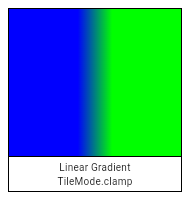
/// 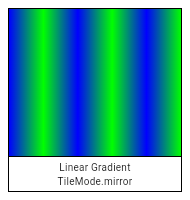
/// 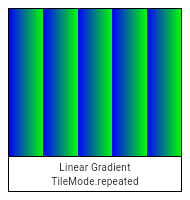
final TileMode tileMode;
@override
Shader createShader(Rect rect, { TextDirection textDirection }) {
return ui.Gradient.linear(
begin.resolve(textDirection).withinRect(rect),
end.resolve(textDirection).withinRect(rect),
colors, _impliedStops(), tileMode, _resolveTransform(rect, textDirection),
);
}
/// Returns a new [LinearGradient] with its colors scaled by the given factor.
///
/// Since the alpha component of the Color is what is scaled, a factor
/// of 0.0 or less results in a gradient that is fully transparent.
@override
LinearGradient scale(double factor) {
return LinearGradient(
begin: begin,
end: end,
colors: colors.map<Color>((Color color) => Color.lerp(null, color, factor)).toList(),
stops: stops,
tileMode: tileMode,
);
}
@override
Gradient lerpFrom(Gradient a, double t) {
if (a == null || (a is LinearGradient))
return LinearGradient.lerp(a, this, t);
return super.lerpFrom(a, t);
}
@override
Gradient lerpTo(Gradient b, double t) {
if (b == null || (b is LinearGradient))
return LinearGradient.lerp(this, b, t);
return super.lerpTo(b, t);
}
/// Linearly interpolate between two [LinearGradient]s.
///
/// If either gradient is null, this function linearly interpolates from a
/// a gradient that matches the other gradient in [begin], [end], [stops] and
/// [tileMode] and with the same [colors] but transparent (using [scale]).
///
/// If neither gradient is null, they must have the same number of [colors].
///
/// The `t` argument represents a position on the timeline, with 0.0 meaning
/// that the interpolation has not started, returning `a` (or something
/// equivalent to `a`), 1.0 meaning that the interpolation has finished,
/// returning `b` (or something equivalent to `b`), and values in between
/// meaning that the interpolation is at the relevant point on the timeline
/// between `a` and `b`. The interpolation can be extrapolated beyond 0.0 and
/// 1.0, so negative values and values greater than 1.0 are valid (and can
/// easily be generated by curves such as [Curves.elasticInOut]).
///
/// Values for `t` are usually obtained from an [Animation<double>], such as
/// an [AnimationController].
static LinearGradient lerp(LinearGradient a, LinearGradient b, double t) {
assert(t != null);
if (a == null && b == null)
return null;
if (a == null)
return b.scale(t);
if (b == null)
return a.scale(1.0 - t);
final _ColorsAndStops interpolated = _interpolateColorsAndStops(
a.colors,
a._impliedStops(),
b.colors,
b._impliedStops(),
t,
);
return LinearGradient(
begin: AlignmentGeometry.lerp(a.begin, b.begin, t),
end: AlignmentGeometry.lerp(a.end, b.end, t),
colors: interpolated.colors,
stops: interpolated.stops,
tileMode: t < 0.5 ? a.tileMode : b.tileMode, // TODO(ianh): interpolate tile mode
);
}
@override
bool operator ==(dynamic other) {
if (identical(this, other))
return true;
if (runtimeType != other.runtimeType)
return false;
final LinearGradient typedOther = other;
if (begin != typedOther.begin ||
end != typedOther.end ||
tileMode != typedOther.tileMode ||
colors?.length != typedOther.colors?.length ||
stops?.length != typedOther.stops?.length)
return false;
if (colors != null) {
assert(typedOther.colors != null);
assert(colors.length == typedOther.colors.length);
for (int i = 0; i < colors.length; i += 1) {
if (colors[i] != typedOther.colors[i])
return false;
}
}
if (stops != null) {
assert(typedOther.stops != null);
assert(stops.length == typedOther.stops.length);
for (int i = 0; i < stops.length; i += 1) {
if (stops[i] != typedOther.stops[i])
return false;
}
}
return true;
}
@override
int get hashCode => hashValues(begin, end, tileMode, hashList(colors), hashList(stops));
@override
String toString() {
return '$runtimeType($begin, $end, $colors, $stops, $tileMode)';
}
}
/// A 2D radial gradient.
///
/// This class is used by [BoxDecoration] to represent radial gradients. This
/// abstracts out the arguments to the [new ui.Gradient.radial] constructor from
/// the `dart:ui` library.
///
/// A normal radial gradient has a [center] and a [radius]. The [center] point
/// corresponds to 0.0, and the ring at [radius] from the center corresponds
/// to 1.0. These lengths are expressed in fractions, so that the same gradient
/// can be reused with varying sized boxes without changing the parameters.
/// (This contrasts with [new ui.Gradient.radial], whose arguments are expressed
/// in logical pixels.)
///
/// It is also possible to create a two-point (or focal pointed) radial gradient
/// (which is sometimes referred to as a two point conic gradient, but is not the
/// same as a CSS conic gradient which corresponds to a [SweepGradient]). A [focal]
/// point and [focalRadius] can be specified similarly to [center] and [radius],
/// which will make the rendered gradient appear to be pointed or directed in the
/// direction of the [focal] point. This is only important if [focal] and [center]
/// are not equal or [focalRadius] > 0.0 (as this case is visually identical to a
/// normal radial gradient). One important case to avoid is having [focal] and
/// [center] both resolve to [Offset.zero] when [focalRadius] > 0.0. In such a case,
/// a valid shader cannot be created by the framework.
///
/// The [colors] are described by a list of [Color] objects. There must be at
/// least two colors. The [stops] list, if specified, must have the same length
/// as [colors]. It specifies fractions of the radius between 0.0 and 1.0,
/// giving concentric rings for each color stop. If it is null, a uniform
/// distribution is assumed.
///
/// The region of the canvas beyond [radius] from the [center] is colored
/// according to [tileMode].
///
/// Typically this class is used with [BoxDecoration], which does the painting.
/// To use a [RadialGradient] to paint on a canvas directly, see [createShader].
///
/// {@tool sample}
///
/// This function draws a gradient that looks like a sun in a blue sky.
///
/// ```dart
/// void paintSky(Canvas canvas, Rect rect) {
/// var gradient = RadialGradient(
/// center: const Alignment(0.7, -0.6), // near the top right
/// radius: 0.2,
/// colors: [
/// const Color(0xFFFFFF00), // yellow sun
/// const Color(0xFF0099FF), // blue sky
/// ],
/// stops: [0.4, 1.0],
/// );
/// // rect is the area we are painting over
/// var paint = Paint()
/// ..shader = gradient.createShader(rect);
/// canvas.drawRect(rect, paint);
/// }
/// ```
/// {@end-tool}
///
/// See also:
///
/// * [LinearGradient], which displays a gradient in parallel lines, and has an
/// example which shows a different way to use [Gradient] objects.
/// * [SweepGradient], which displays a gradient in a sweeping arc around a
/// center point.
/// * [BoxDecoration], which can take a [RadialGradient] in its
/// [BoxDecoration.gradient] property.
/// * [CustomPainter], which shows how to use the above sample code in a custom
/// painter.
class RadialGradient extends Gradient {
/// Creates a radial gradient.
///
/// The [colors] argument must not be null. If [stops] is non-null, it must
/// have the same length as [colors].
const RadialGradient({
this.center = Alignment.center,
this.radius = 0.5,
@required List<Color> colors,
List<double> stops,
this.tileMode = TileMode.clamp,
this.focal,
this.focalRadius = 0.0,
GradientTransform transform,
}) : assert(center != null),
assert(radius != null),
assert(tileMode != null),
assert(focalRadius != null),
super(colors: colors, stops: stops, transform: transform);
/// The center of the gradient, as an offset into the (-1.0, -1.0) x (1.0, 1.0)
/// square describing the gradient which will be mapped onto the paint box.
///
/// For example, an alignment of (0.0, 0.0) will place the radial
/// gradient in the center of the box.
///
/// If this is an [Alignment], then it is expressed as a vector from
/// coordinate (0.0, 0.0), in a coordinate space that maps the center of the
/// paint box at (0.0, 0.0) and the bottom right at (1.0, 1.0).
///
/// It can also be an [AlignmentDirectional], where the start is the left in
/// left-to-right contexts and the right in right-to-left contexts. If a
/// text-direction-dependent value is provided here, then the [createShader]
/// method will need to be given a [TextDirection].
final AlignmentGeometry center;
/// The radius of the gradient, as a fraction of the shortest side
/// of the paint box.
///
/// For example, if a radial gradient is painted on a box that is
/// 100.0 pixels wide and 200.0 pixels tall, then a radius of 1.0
/// will place the 1.0 stop at 100.0 pixels from the [center].
final double radius;
/// How this gradient should tile the plane beyond the outer ring at [radius]
/// pixels from the [center].
///
/// For details, see [TileMode].
///
/// 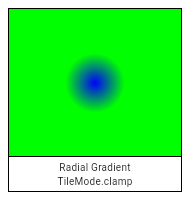
/// 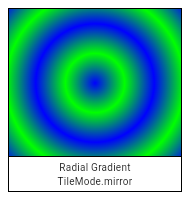
/// 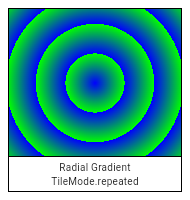
///
/// 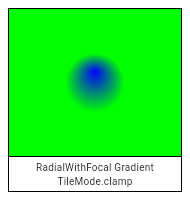
/// 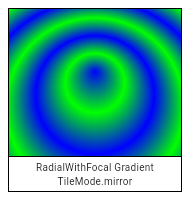
/// 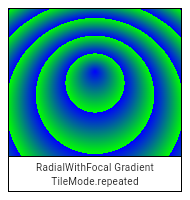
final TileMode tileMode;
/// The focal point of the gradient. If specified, the gradient will appear
/// to be focused along the vector from [center] to focal.
///
/// See [center] for a description of how the coordinates are mapped.
///
/// If this value is specified and [focalRadius] > 0.0, care should be taken
/// to ensure that either this value or [center] will not both resolve to
/// [Offset.zero], which would fail to create a valid gradient.
final AlignmentGeometry focal;
/// The radius of the focal point of gradient, as a fraction of the shortest
/// side of the paint box.
///
/// For example, if a radial gradient is painted on a box that is
/// 100.0 pixels wide and 200.0 pixels tall, then a radius of 1.0
/// will place the 1.0 stop at 100.0 pixels from the [focus].
///
/// If this value is specified and is greater than 0.0, either [focal] or
/// [center] must not resolve to [Offset.zero], which would fail to create
/// a valid gradient.
final double focalRadius;
@override
Shader createShader(Rect rect, { TextDirection textDirection }) {
return ui.Gradient.radial(
center.resolve(textDirection).withinRect(rect),
radius * rect.shortestSide,
colors, _impliedStops(), tileMode,
_resolveTransform(rect, textDirection),
focal == null ? null : focal.resolve(textDirection).withinRect(rect),
focalRadius * rect.shortestSide,
);
}
/// Returns a new [RadialGradient] with its colors scaled by the given factor.
///
/// Since the alpha component of the Color is what is scaled, a factor
/// of 0.0 or less results in a gradient that is fully transparent.
@override
RadialGradient scale(double factor) {
return RadialGradient(
center: center,
radius: radius,
colors: colors.map<Color>((Color color) => Color.lerp(null, color, factor)).toList(),
stops: stops,
tileMode: tileMode,
focal: focal,
focalRadius: focalRadius,
);
}
@override
Gradient lerpFrom(Gradient a, double t) {
if (a == null || (a is RadialGradient))
return RadialGradient.lerp(a, this, t);
return super.lerpFrom(a, t);
}
@override
Gradient lerpTo(Gradient b, double t) {
if (b == null || (b is RadialGradient))
return RadialGradient.lerp(this, b, t);
return super.lerpTo(b, t);
}
/// Linearly interpolate between two [RadialGradient]s.
///
/// If either gradient is null, this function linearly interpolates from a
/// a gradient that matches the other gradient in [center], [radius], [stops] and
/// [tileMode] and with the same [colors] but transparent (using [scale]).
///
/// If neither gradient is null, they must have the same number of [colors].
///
/// The `t` argument represents a position on the timeline, with 0.0 meaning
/// that the interpolation has not started, returning `a` (or something
/// equivalent to `a`), 1.0 meaning that the interpolation has finished,
/// returning `b` (or something equivalent to `b`), and values in between
/// meaning that the interpolation is at the relevant point on the timeline
/// between `a` and `b`. The interpolation can be extrapolated beyond 0.0 and
/// 1.0, so negative values and values greater than 1.0 are valid (and can
/// easily be generated by curves such as [Curves.elasticInOut]).
///
/// Values for `t` are usually obtained from an [Animation<double>], such as
/// an [AnimationController].
static RadialGradient lerp(RadialGradient a, RadialGradient b, double t) {
assert(t != null);
if (a == null && b == null)
return null;
if (a == null)
return b.scale(t);
if (b == null)
return a.scale(1.0 - t);
final _ColorsAndStops interpolated = _interpolateColorsAndStops(
a.colors,
a._impliedStops(),
b.colors,
b._impliedStops(),
t,
);
return RadialGradient(
center: AlignmentGeometry.lerp(a.center, b.center, t),
radius: math.max(0.0, ui.lerpDouble(a.radius, b.radius, t)),
colors: interpolated.colors,
stops: interpolated.stops,
tileMode: t < 0.5 ? a.tileMode : b.tileMode, // TODO(ianh): interpolate tile mode
focal: AlignmentGeometry.lerp(a.focal, b.focal, t),
focalRadius: math.max(0.0, ui.lerpDouble(a.focalRadius, b.focalRadius, t)),
);
}
@override
bool operator ==(dynamic other) {
if (identical(this, other))
return true;
if (runtimeType != other.runtimeType)
return false;
final RadialGradient typedOther = other;
if (center != typedOther.center ||
radius != typedOther.radius ||
tileMode != typedOther.tileMode ||
colors?.length != typedOther.colors?.length ||
stops?.length != typedOther.stops?.length ||
focal != typedOther.focal ||
focalRadius != typedOther.focalRadius)
return false;
if (colors != null) {
assert(typedOther.colors != null);
assert(colors.length == typedOther.colors.length);
for (int i = 0; i < colors.length; i += 1) {
if (colors[i] != typedOther.colors[i])
return false;
}
}
if (stops != null) {
assert(typedOther.stops != null);
assert(stops.length == typedOther.stops.length);
for (int i = 0; i < stops.length; i += 1) {
if (stops[i] != typedOther.stops[i])
return false;
}
}
return true;
}
@override
int get hashCode => hashValues(center, radius, tileMode, hashList(colors), hashList(stops), focal, focalRadius);
@override
String toString() {
return '$runtimeType($center, $radius, $colors, $stops, $tileMode, $focal, $focalRadius)';
}
}
/// A 2D sweep gradient.
///
/// This class is used by [BoxDecoration] to represent sweep gradients. This
/// abstracts out the arguments to the [new ui.Gradient.sweep] constructor from
/// the `dart:ui` library.
///
/// A gradient has a [center], a [startAngle], and an [endAngle]. The [startAngle]
/// corresponds to 0.0, and the [endAngle] corresponds to 1.0. These angles are
/// expressed in radians.
///
/// The [colors] are described by a list of [Color] objects. There must be at
/// least two colors. The [stops] list, if specified, must have the same length
/// as [colors]. It specifies fractions of the vector from start to end, between
/// 0.0 and 1.0, for each color. If it is null, a uniform distribution is
/// assumed.
///
/// The region of the canvas before [startAngle] and after [endAngle] is colored
/// according to [tileMode].
///
/// Typically this class is used with [BoxDecoration], which does the painting.
/// To use a [SweepGradient] to paint on a canvas directly, see [createShader].
///
/// {@tool sample}
///
/// This sample draws a different color in each quadrant.
///
/// ```dart
/// Container(
/// decoration: BoxDecoration(
/// gradient: SweepGradient(
/// center: FractionalOffset.center,
/// startAngle: 0.0,
/// endAngle: math.pi * 2,
/// colors: const <Color>[
/// Color(0xFF4285F4), // blue
/// Color(0xFF34A853), // green
/// Color(0xFFFBBC05), // yellow
/// Color(0xFFEA4335), // red
/// Color(0xFF4285F4), // blue again to seamlessly transition to the start
/// ],
/// stops: const <double>[0.0, 0.25, 0.5, 0.75, 1.0],
/// ),
/// )
/// )
/// ```
/// {@end-tool}
///
/// {@tool sample}
///
/// This sample takes the above gradient and rotates it by `math.pi/4` radians,
/// i.e. 45 degrees.
///
/// ```dart
/// Container(
/// decoration: BoxDecoration(
/// gradient: SweepGradient(
/// center: FractionalOffset.center,
/// startAngle: 0.0,
/// endAngle: math.pi * 2,
/// colors: const <Color>[
/// Color(0xFF4285F4), // blue
/// Color(0xFF34A853), // green
/// Color(0xFFFBBC05), // yellow
/// Color(0xFFEA4335), // red
/// Color(0xFF4285F4), // blue again to seamlessly transition to the start
/// ],
/// stops: const <double>[0.0, 0.25, 0.5, 0.75, 1.0],
/// transform: GradientRotation(math.pi/4),
/// ),
/// ),
/// )
/// ```
/// {@end-tool}
///
/// See also:
///
/// * [LinearGradient], which displays a gradient in parallel lines, and has an
/// example which shows a different way to use [Gradient] objects.
/// * [RadialGradient], which displays a gradient in concentric circles, and
/// has an example which shows a different way to use [Gradient] objects.
/// * [BoxDecoration], which can take a [SweepGradient] in its
/// [BoxDecoration.gradient] property.
class SweepGradient extends Gradient {
/// Creates a sweep gradient.
///
/// The [colors] argument must not be null. If [stops] is non-null, it must
/// have the same length as [colors].
const SweepGradient({
this.center = Alignment.center,
this.startAngle = 0.0,
this.endAngle = math.pi * 2,
@required List<Color> colors,
List<double> stops,
this.tileMode = TileMode.clamp,
GradientTransform transform,
}) : assert(center != null),
assert(startAngle != null),
assert(endAngle != null),
assert(tileMode != null),
super(colors: colors, stops: stops, transform: transform);
/// The center of the gradient, as an offset into the (-1.0, -1.0) x (1.0, 1.0)
/// square describing the gradient which will be mapped onto the paint box.
///
/// For example, an alignment of (0.0, 0.0) will place the sweep
/// gradient in the center of the box.
///
/// If this is an [Alignment], then it is expressed as a vector from
/// coordinate (0.0, 0.0), in a coordinate space that maps the center of the
/// paint box at (0.0, 0.0) and the bottom right at (1.0, 1.0).
///
/// It can also be an [AlignmentDirectional], where the start is the left in
/// left-to-right contexts and the right in right-to-left contexts. If a
/// text-direction-dependent value is provided here, then the [createShader]
/// method will need to be given a [TextDirection].
final AlignmentGeometry center;
/// The angle in radians at which stop 0.0 of the gradient is placed.
///
/// Defaults to 0.0.
final double startAngle;
/// The angle in radians at which stop 1.0 of the gradient is placed.
///
/// Defaults to math.pi * 2.
final double endAngle;
/// How this gradient should tile the plane beyond in the region before
/// [startAngle] and after [endAngle].
///
/// For details, see [TileMode].
///
/// 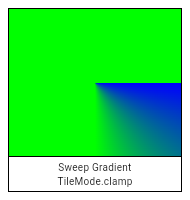
/// 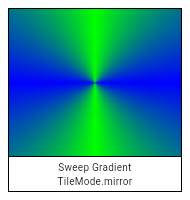
/// 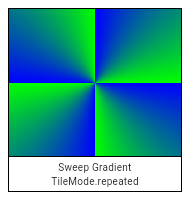
final TileMode tileMode;
@override
Shader createShader(Rect rect, { TextDirection textDirection }) {
return ui.Gradient.sweep(
center.resolve(textDirection).withinRect(rect),
colors, _impliedStops(), tileMode,
startAngle,
endAngle,
_resolveTransform(rect, textDirection),
);
}
/// Returns a new [SweepGradient] with its colors scaled by the given factor.
///
/// Since the alpha component of the Color is what is scaled, a factor
/// of 0.0 or less results in a gradient that is fully transparent.
@override
SweepGradient scale(double factor) {
return SweepGradient(
center: center,
startAngle: startAngle,
endAngle: endAngle,
colors: colors.map<Color>((Color color) => Color.lerp(null, color, factor)).toList(),
stops: stops,
tileMode: tileMode,
);
}
@override
Gradient lerpFrom(Gradient a, double t) {
if (a == null || (a is SweepGradient))
return SweepGradient.lerp(a, this, t);
return super.lerpFrom(a, t);
}
@override
Gradient lerpTo(Gradient b, double t) {
if (b == null || (b is SweepGradient))
return SweepGradient.lerp(this, b, t);
return super.lerpTo(b, t);
}
/// Linearly interpolate between two [SweepGradient]s.
///
/// If either gradient is null, then the non-null gradient is returned with
/// its color scaled in the same way as the [scale] function.
///
/// If neither gradient is null, they must have the same number of [colors].
///
/// The `t` argument represents a position on the timeline, with 0.0 meaning
/// that the interpolation has not started, returning `a` (or something
/// equivalent to `a`), 1.0 meaning that the interpolation has finished,
/// returning `b` (or something equivalent to `b`), and values in between
/// meaning that the interpolation is at the relevant point on the timeline
/// between `a` and `b`. The interpolation can be extrapolated beyond 0.0 and
/// 1.0, so negative values and values greater than 1.0 are valid (and can
/// easily be generated by curves such as [Curves.elasticInOut]).
///
/// Values for `t` are usually obtained from an [Animation<double>], such as
/// an [AnimationController].
static SweepGradient lerp(SweepGradient a, SweepGradient b, double t) {
assert(t != null);
if (a == null && b == null)
return null;
if (a == null)
return b.scale(t);
if (b == null)
return a.scale(1.0 - t);
final _ColorsAndStops interpolated = _interpolateColorsAndStops(
a.colors,
a._impliedStops(),
b.colors,
b._impliedStops(),
t,
);
return SweepGradient(
center: AlignmentGeometry.lerp(a.center, b.center, t),
startAngle: math.max(0.0, ui.lerpDouble(a.startAngle, b.startAngle, t)),
endAngle: math.max(0.0, ui.lerpDouble(a.endAngle, b.endAngle, t)),
colors: interpolated.colors,
stops: interpolated.stops,
tileMode: t < 0.5 ? a.tileMode : b.tileMode, // TODO(ianh): interpolate tile mode
);
}
@override
bool operator ==(dynamic other) {
if (identical(this, other))
return true;
if (runtimeType != other.runtimeType)
return false;
final SweepGradient typedOther = other;
if (center != typedOther.center ||
startAngle != typedOther.startAngle ||
endAngle != typedOther.endAngle ||
tileMode != typedOther.tileMode ||
colors?.length != typedOther.colors?.length ||
stops?.length != typedOther.stops?.length)
return false;
if (colors != null) {
assert(typedOther.colors != null);
assert(colors.length == typedOther.colors.length);
for (int i = 0; i < colors.length; i += 1) {
if (colors[i] != typedOther.colors[i])
return false;
}
}
if (stops != null) {
assert(typedOther.stops != null);
assert(stops.length == typedOther.stops.length);
for (int i = 0; i < stops.length; i += 1) {
if (stops[i] != typedOther.stops[i])
return false;
}
}
return true;
}
@override
int get hashCode => hashValues(center, startAngle, endAngle, tileMode, hashList(colors), hashList(stops));
@override
String toString() {
return '$runtimeType($center, $startAngle, $endAngle, $colors, $stops, $tileMode)';
}
}